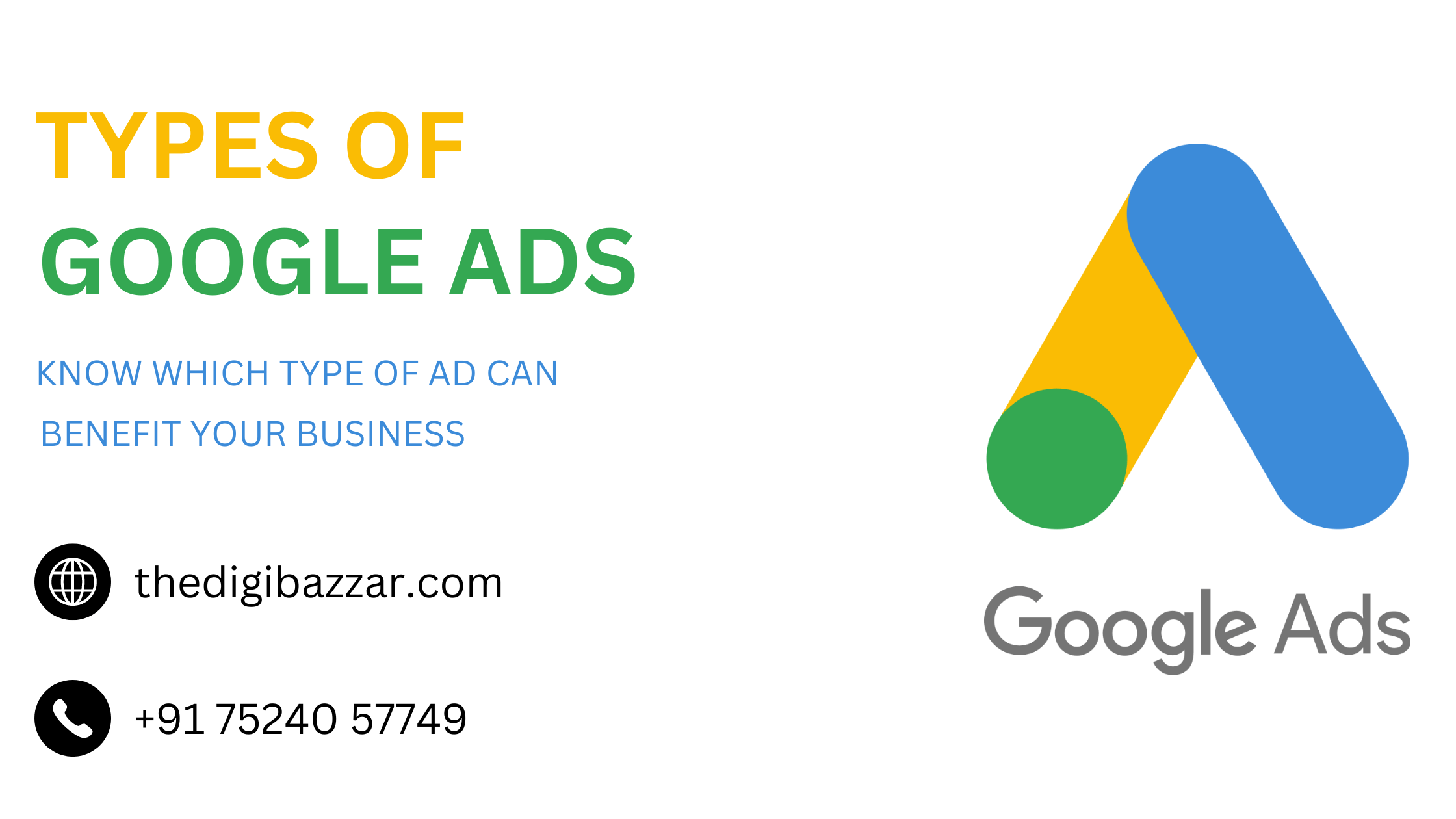Types of Google Ads and Their Use
What is Google Ads?
Google Ads, formerly known as Google AdWords, is an online advertising platform developed by Google. It allows businesses to create ads that appear on Google’s search engine results page (SERP), YouTube, and other websites that are part of the Google Display Network. The platform operates on a pay-per-click (PPC) model, meaning advertisers pay only when users interact with their ads. Google Ads is a powerful tool that can drive targeted traffic to your website, increase brand awareness, and ultimately boost sales. So let us the types of Google ads
How Google Ads Can Benefit Your Business
1. Increased Visibility: Google Ads ensures your business appears in front of potential customers when they are actively searching for products or services similar to what you offer. This increased visibility can lead to higher traffic and more sales.
2. Cost-Effective: With Google Ads, you control your advertising budget. The PPC model means you only pay when someone clicks on your ad, ensuring your advertising spend is used efficiently.
3. Measurable Results: Google Ads provides detailed analytics and reporting tools. You can track impressions, clicks, conversions, and other metrics to measure the performance of your ads and make data-driven decisions.
4. Targeted Advertising: Google Ads allows you to target specific demographics, geographic locations, languages, and even the time of day your ads are shown. This precise targeting helps you reach the right audience.
5. Quick Results: Unlike search engine optimization (SEO), which can take months to show results, Google Ads can drive traffic to your site almost immediately after your campaign goes live.
6. Flexibility and Control: You can start, stop, or adjust your campaigns at any time. This flexibility allows you to respond quickly to market changes or business needs.
Types of Google Ads and Their Use
Understanding the different types of Google Ads campaigns can help you choose the best strategy for your business. Here are the primary types of Google Ads and their uses:
1. Search Ads
Use: Search Ads are text-based ads that appear on the Google search results page when users search for specific keywords. They are ideal for businesses looking to capture potential customers who are actively searching for products or services similar to what they offer.
Example: A user searching for “best running shoes” may see an ad from a sports store selling running shoes.
Key Benefits:
• High Intent: Users searching for specific keywords have a high intent to purchase.
• Direct Traffic: Drives targeted traffic directly to your website.
• Cost Control: You can set a maximum cost-per-click (CPC) for your ads.
2. Display Ads
Use: Display Ads are visual ads (images or videos) that appear on websites within the Google Display Network. They are useful for increasing brand awareness and reaching a wider audience across the internet.
Example: A clothing brand can display its ads on fashion blogs or news sites to attract potential customers.
Key Benefits:
• Visual Appeal: Use images and videos to capture attention.
• Wide Reach: Access millions of websites and apps in the Google Display Network.
• Retargeting: Show ads to users who have previously visited your site.
3. Shopping Ads
Use: Shopping Ads display product images, prices, and merchant information directly on the Google search results page. They are perfect for e-commerce businesses looking to showcase their products and drive traffic to their online store.
Example: When a user searches for “laptop deals,” Shopping Ads from various electronic retailers appear with images and prices of different laptops.
Key Benefits:
• Product Focused: Highlight specific products with images and prices.
• Qualified Leads: Attract users with high purchase intent.
• Competitive Edge: Stand out with visually appealing product ads.
4. Video Ads
Use: Video Ads appear on YouTube and across the Google Display Network. They are highly engaging and can be used to build brand awareness, promote products, or tell a brand story.
Example: A beauty brand can create a tutorial video ad showing how to use their makeup products and target users interested in beauty tips.
Key Benefits:
• Engagement: Video content is highly engaging and memorable.
• Reach: Access billions of YouTube users.
• Versatility: Use different video formats for various objectives.
5. App Ads
Use: App Ads promote mobile applications across Google’s properties, including Search, Play, YouTube, and the Google Display Network. They help drive app downloads and engagement.
Example: A game developer can run App Ads to attract new players to download their latest game.
Key Benefits:
• Cross-Platform: Promote your app across multiple Google properties.
• Automated Optimization: Google optimizes your ads to reach the right users.
• Increased Downloads: Drive more app installs and user engagement.
6. Local Ads
Use: Local Ads promote your business to people in your vicinity. They are great for businesses with physical locations, like restaurants, stores, or service providers.
Example: A user searching for “coffee shop near me” may see a Local Ad for a nearby café.
Key Benefits:
• Local Targeting: Reach potential customers in your area.
• Mobile Optimization: Ideal for users searching on their mobile devices.
• Drive Foot Traffic: Increase visits to your physical location.
Conclusion
Choosing the right type of Google Ads campaign can significantly impact your business’s success. By understanding the different types of Google Ads campaigns and their specific uses, you can create a targeted and effective advertising strategy that drives traffic, increases sales, and builds brand awareness. Remember to monitor your ad performance regularly and make adjustments to optimize your campaigns for the best results.
In summary, Google Ads is a versatile platform that offers various campaign types to suit different business needs. Whether you aim to increase website traffic, drive product sales, boost app downloads, or enhance brand awareness, there’s a Google Ads type that can help you achieve your goals. Use this guide to navigate the different options and create a powerful advertising strategy tailored to your business.
Read Our Other Blog “SEO for New Websites”
